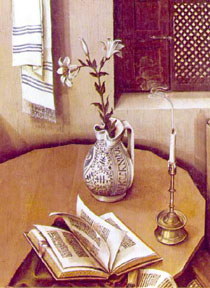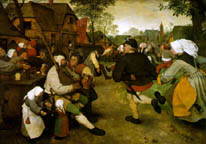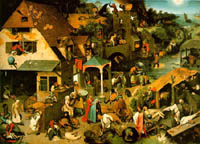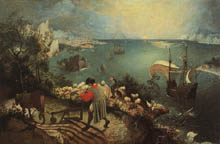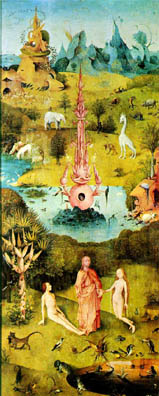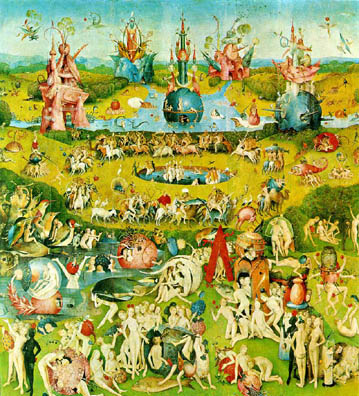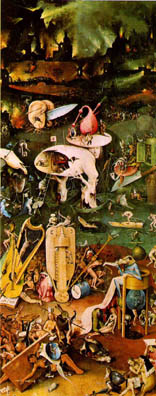The
Northern Renaissance
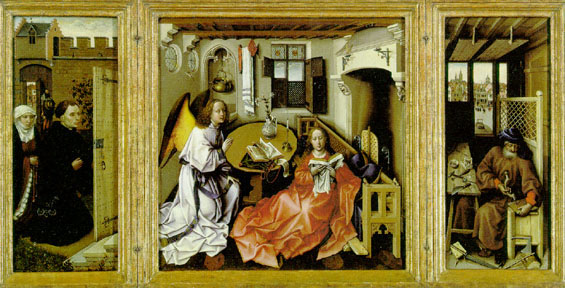
Robert Campin, The Merode
Altarpiece, 1426
|
The Renaissance in the north
has a distinctively different character than that of Italy and the southern
countries.Though the styles of Northern artists vary according to geography,
one characteristic that is fundamental to all northern art of this period
is a fondness for meticulous rendering of details. In addition, there is
generally less of the classical ideal apparent in the figures (which can
be partly explained by their lack of access to Greek and Roman statues).
Instead, remnants of Gothic influences are apparent in their compositions.
|
The Merode Altarpiece was created by Robert Campin, a Flemish artist (previously known as "the
Master of Flemale"). The picture is a triptych, composed in
three hinged panels (the outer wings can be closed over the middle panel,
and probably has another painting on the closed wings). A particularly
northern aspect of this painting are the many details, which are rich
with symbolic meaning. The central panel focuses on Mary, who is absorbed
in her reading. The angel Gabriel comes to her, announcing that she will
be the mother of the Christ child. Symbols of her purity include the vase
of white lillies, the open biblical text, and the white linen. Close inspection
also reveals an image of Christ on the Cross, floating from the direction
of the circular windows, and the extinguished candle probably also relates
to his death. The tilted perspective of the room allows all of the contents
to be seen more easily than if he had used linear perspective (which has,
by now, spread to the north, but not always used). Note also the gothic
details evident in the architecture. To the left, a couple kneels at Mary's
doorway to witness the scene (these are the donors who paid for the painting),
and the right panel reveals Joseph working in his workshop. He is building
mouse-traps, which is symbolic of Jesus' "trapping" of evil.
|
Jan van Eyck was important not
only to the northern Renaissance, but to the entire Renaissance. He is credited
with the invention of the oil-glazing technique, which replaced the earlier
egg-tempera method. In the early years of the Renaissance, the artist generally
began with a monochromatic drawing using egg tempera on a wood panel, and
then layers of oil-glazes were painted on top of it. This allowed for rich
details and luminous colors (later artists would work directly in oils on
canvas, allowing the paintings to become larger and lighter, without warping
or insect infestation). Whether or not Van Eyck was actually the first person
to use this new medium may be of secondary importance to the achievements
of his work, for he was truly a master of meticulous detail and well-planned
compositions.
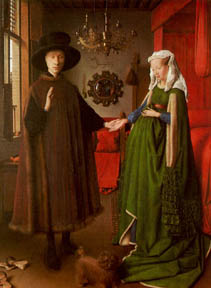
Jan van Eyck, Arnolfini Wedding, 1434
|
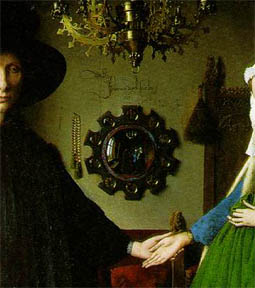
Arnolfini Wedding (wall detail)
|
The Marriage of
Giovanni Arnolfini, commonly called the Arnolfini Wedding, is van Eyck's most
famous work. The subject is obvious, given the pose of the couple. It may,
however, be confusing to the modern viewer that he chose to portray them in
their bed chamber, instead of in a church. Here, it is necessary to keep in
mind that everything portrayed in this picture has symbolic meaning. The fact
that the woman appears to be pregnant is symbolic of the holy purpose of their
matrimony of bringing children into the world. This also explains the choice
of the color of her dress (green representing fertility), and the fact that
she is pulling her dress up in the front (signifying that she is willing to
bear children). Other specifically sybolic imagery includes the dog who stands
between them (fidelity to each other; loyalty to God), the sandals which have
been removed (signifying that they are standing on holy ground), and the single
candle in the candelabra (the presence of Christ in their union). A detail
of the back wall reveals a convex mirror which reflects their backs and two
other persons (probably the priest and the artist). A signature above which
says "Jan van Eyck was here" testifies to the artist's presence
during the ceremony, and it is possible that the purpose of the painting is
partly a matter of documenting the legality of their matrimony.
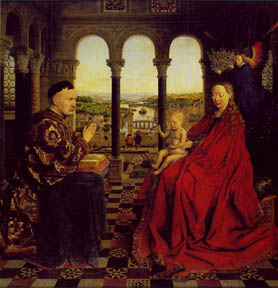
Madonna and Chancellor
Rolin
|
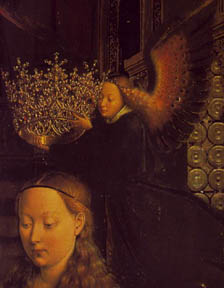
(Detail of Angel bearing
Crown)
|
I chose to add a
couple of images of the Madonna and Chancellor Rolin to emphasize the beauty
of details in van Eyck's works. The Madonna and child appears to a contemporary
figure in the Renaissance church, who shows his devotion in his praying hands.
Architectural details are sumptuously rich, including the carved figures on
the capitals of columns and the patterning in the tiles and glass. Outside,
there are two persons enjoying the view of the landscape. Every hair on the
Virgin's head is clearly dilineated, and the crown which the angel places
there is elaborately detailed.
Albrecht
Durer
(German)
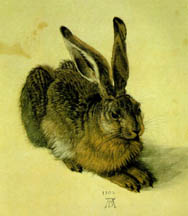
Study of a Hare
|
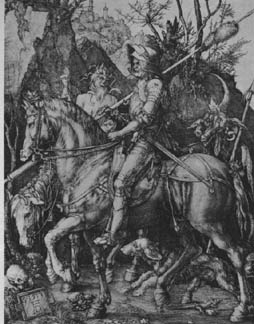
The Knight, Death, and
the Devil
|
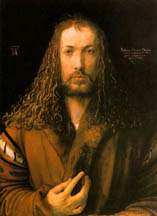
Self Portrait
|
I chose these three images to represent the diversity of Durer's talents.
The watercolor study of a hare shows his intimate interest in nature, for
he, like Leonardo, believed that it was necessary for an artist to study all
aspects of his world. He was one of the first artists to use the medium of
watercolor (though I'm unsure if he is credited with its invention). He was
foremost a printmaker, and thousands of his etchings were distributed across
Europe, making him one of the most famous artists of his day. He was also
very well-travelled, and his many trips to Italy was useful in influencing
his work (which was thereafter an influence to other northerners). The self
portrait reveals Durer's mastery with the oil painting medium, and especially
interesting in its Christ-like pose.
Though the imagery of his Knight,
Death and the Devil is influenced by his travels to Italy, the rich iconography
is an element of his Northern upbringing. The knight represents the "good
Christian soldier", who is traveling through the "forest of darkness"
to arrive at the "kingdom of light". On his way, he encounters Death
(the old man with serpents for hair) and the Devil (the single-horned goat),
but he does not even give them a moment's glance. He is steadfast in his aim,
accompanied by his faithful dog (representing loyalty). There is a small lizard
below the hind legs of his horse going the opposite direction. Anything reptilian
generally connotes evil in Christian iconography, and also serves to emphasize
that his is going the right direction. In the left corner is a skull, symbolic
of the fate of all mankind, just above Albrecht Durer's signature, "A.D."
Hans
Holbein
(German)
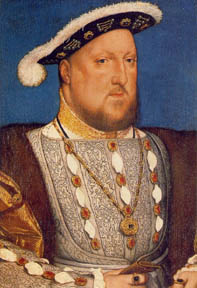
King Henry VIII
|
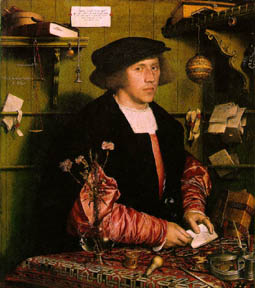
Portrait of Gisze
|
Another important northern Renaissance artist was Hans Holbein, who, like
Durer, did a considerable amount of travelling throughout Europe. He is known
primarily as a court painter, for he was at one point employed by the English
King, Henry VIII. This is one of two paintings he did of the king (the other
is more famous), but he also portrayed some of his wives (including Anne of
Cleves), and many of the people included in the royal court. In all, he pays
careful attention to portraying a faithful likeness, and the richness of details
and surface textures exhibits his northern upbringing. There is something
about his paintings that do more than to say, "this is what this person
looks like", however. His understanding of personalities is apparent
in his renderings. Henry appears unapproachable and powerful. Another portrait
of a prosperous merchant reveals a slight timidity. The surrounding details
also reveals something of the man's personality, as well as objects regarding
his trade.
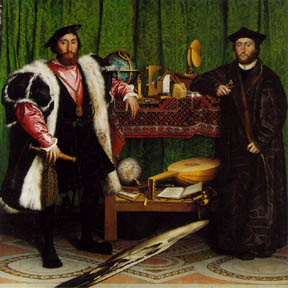
The Ambassadors
|
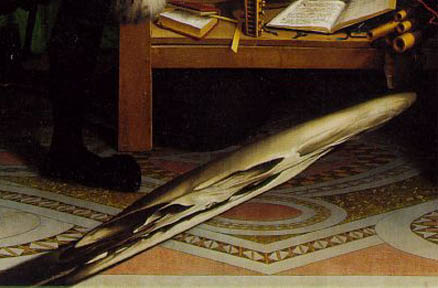
(Detail of Ambassadors
Reveals Skull)
|
One of my favorite Renaissance paintings is Holbein's Ambassadors. These men
were members of King Henry VIII's court, and are portrayed with objects relating
to their worldliness and higher learning: two globes, a lute, books, and navigational
instruments. The fur robes and silk sleeves also illustrate their great wealth.
Even the tapestry, the floor tiles, and the textured silk curtain illustrate
their status and refinement. Amid all of this, a slurred image is presented
across the bottom of the painting. If you were to look at the painting from
the extreme right, an image of a skull becomes apparent. This type of twisted
perspective is called "anamorphic art". Its meaning in relationship
to the painting is probably related to the idea that death comes to us all,
no matter what one's status in life. Another possibility is that it makes
reference to Holbein's name, which in German means "hollow bone".
Pieter
Brueghel
(Netherlands)
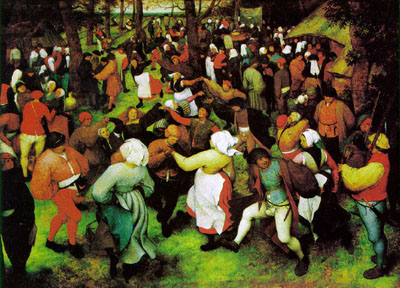
The Wedding Dance
Pieter Brueghel is an extremely
interesting character in northern Renaissance painting. His is perhaps the
most fun to look at, and at first glance, seems much less serious than most
artists of his time. He is one of few artists who focuses his eyes on the
lives of peasants, instead of the church or royalty. Despite its seeming frivolity,
much of his work has serious moral undertones. The Wedding Dance, for
instance, is one of a series on the subject of such celebrations. Everything
seems innocent enough here, but details reveal the bawdiness of activities
within the scene.
Peasant Dance, below, depicts
the celebration of a Holy Day (a close detail would reveal a picture of Mary
and announcement of the festival tacked to a tree). While couples dance, other
details reveal drinking, fighting, and public kissing. One woman even leads
a man into an inn. All serves to illustrate how people use a supposed "holy
day" as an excuse to indulge in vices.
(The complexity of Brueghel's work warrants
a closer look. Click the pictures or text below)
Neverlandish Proverbs relates
to northern parables, and has a multitude of surreal details, such as pies
on the roof and a man bashing his head against a wall. The meaning of most
of these images are now lost, but it is certain that they include some type
of moral commentary.
Another of my favorites is The
Fall of Icarus. The landscape is dominated by ordinary activities: a man
plowing his land, a shepherd tending his sheep, and a merchant ship coming
to port. No one is paying attention to the legs that stick up out of the water,
at the right of the composition. The title tells you that this is Icarus,
who's father built him wax wings to fly with, but did not heed his father's
advice against flying too close to the sun.
Hieronymous
Bosch
(Netherlands)
The
Garden of Earthly Delights
(click pictures above for details of each)
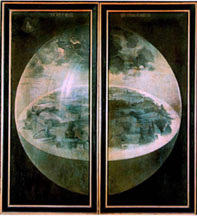
The Creation of the World
( Closed Triptych Panels)
|
Another extremely interesting
artist of the northern Renaissance is Hieronymous Bosch. He was the
creator of many paintings, but his Garden of Earthly Delights is by far his most famous. As with Brueghel's work, everything appears
to be pretty frivolous at first, until you recognize the moral of the
story. There is a sequence, which can be read from left to right. First,
there is the creation of the garden, which is represented by a paradisal
landscape: Adam and Eve are joined by God (or Jesus?), and surrounded
by fantasy animals. The central panel represents life on earth, complete
with its carnal delights and vices. Everyone seems to be having a pretty
good time, as they eat fruit and there is a lot of details related to
sexual play. It is in the final panel that the message is conveyed:
hell is played out in all of its gruesomeness. The punishment for sinners
is that they will be tortured by whatever was their vice. The apocalyptic
scenery is the clear opposite of what is portrayed in the Garden of
Paradise.
(Bosch's rich imagination and elements of fantasy will directly inspire
artists of the 20th century who will be part of the Surrealist movement).
|
Matthais
Grunewald
(German)
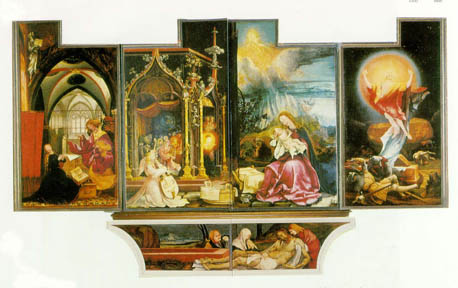
The
Isenheim Altarpiece
(open)
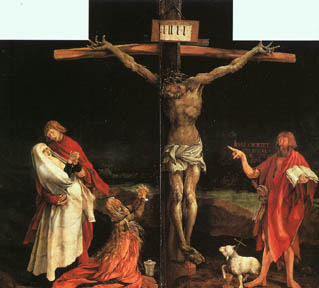
Crucifixion of Christ (closed wings on Isenheim Altarpiece)
|
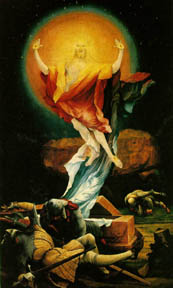
The Resurrection (right wing)
|
Another artist whose work has
a strong element of fantasy is Matthais Grunewald. The Isenheim altarpiece
is another triptcyh painting which reveals several related biblical subjects.
When the painting is closed, it displays an image of the Crucifixion. This
is one of the most morbid images of Christ, as his skin is pockmarked with
wounds, and his flesh is torn and distorted where the nails have been driven
through him (the pockmarks possibly relate to the fact that the painting
was originally created for a hospital for persons with skin diseases, and
would help the patients to identify thier suffering with that of Christ's).
Mother Mary swoons backwards, and is comforted by another saint, while Mary
Magdalen kneels in fervent prayer. St. John the Baptist points to Jesus,
accompanied by a lamb holding the cross (signifying his martyrdom as the
"lamb of God").
The opened painting reveals the life of Jesus, beginning with the Annunciation,
where Mary is told that she is to bear the immaculate conception, to Jesus's
birth, and his later resurrection from death. Once more, if these inner
panels are opened, it reveals yet another painting, this one of the Temptation
of St. Anthony. Here, St. Anthony wanders through the forest, and is
taunted by a vision of torturing monsters. Perhaps the whole significance
is that pain is an illusion created by evil, and that the faithful will
overcome this illusion and will be welcomed by the glories of the afterlife
if their faith remains strong.
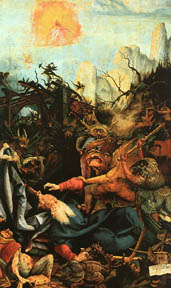
The Temptation of St.
Anthony
(interior of triptych)
|
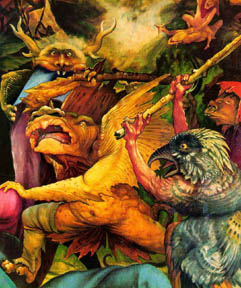
Detail of Demons,
(Temptation of St. Anthony)
|
to Leonardo
|


